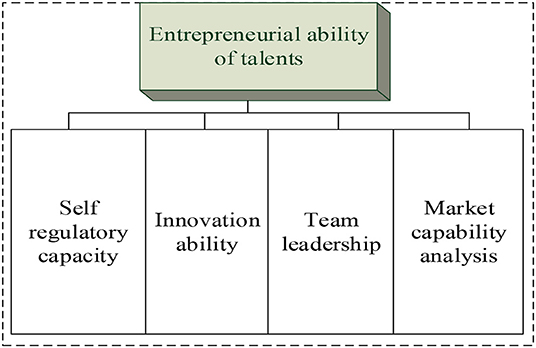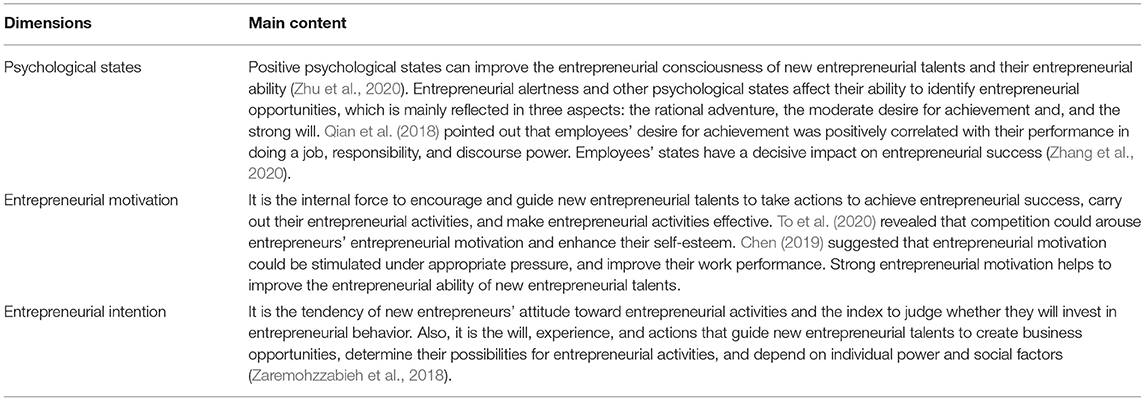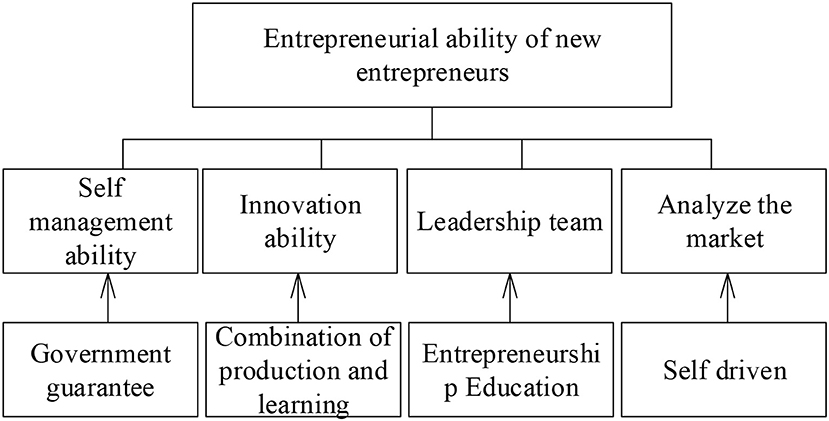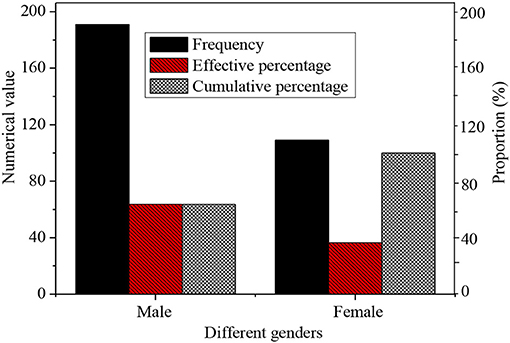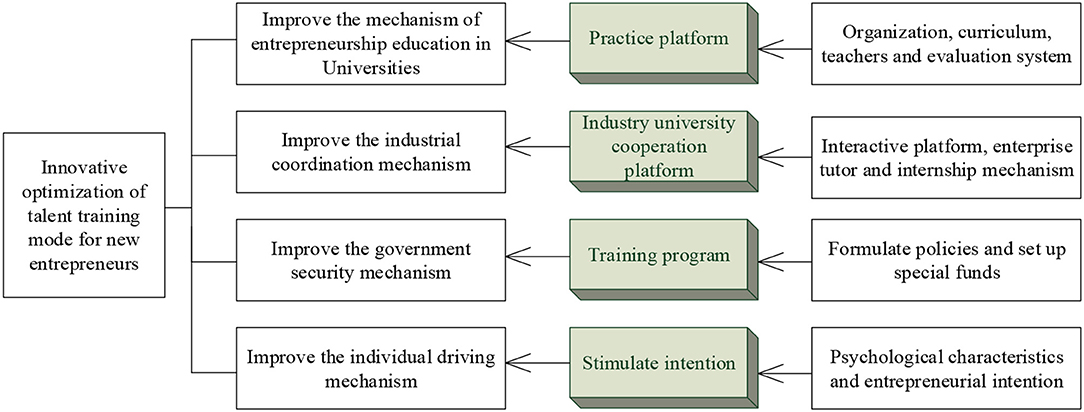- Party School of CPC Shandong Provincial Committee, Jinan, China
With the development of the social economy, more and more talents are required in economic construction and innovation. The study aims to cultivate new entrepreneurial talents and promote the overall development of new ventures. First, the entrepreneurial ability of new entrepreneurial talents is analyzed, and the feasibility of improving the entrepreneurial ability of new entrepreneurial talents is verified. Second, the architecture is designed for improving the entrepreneurial ability of new entrepreneurial talents. About 350 employees in 20 ventures in Xi'an, Shaanxi Province are randomly selected as the subjects for a questionnaire survey (QS). Three-fifty questionnaires are distributed and 300 are collected. Descriptive statistics are used to analyze the 300 valid questionnaires. Then, the relationship between the psychological states of new entrepreneurial talents and their entrepreneurial ability is explored, and the influencing factors in the development of new entrepreneurial talents are analyzed. The results show that the number of employees in most ventures is between 250 and 400 and the age of the employees in the tested new ventures is between 35 and 40. More than one-third of employees are managers and over 86% of them have a degree of bachelor or above. The scores of the scale of the psychological state of new entrepreneurs are high. This shows that most of the new entrepreneurs have a high educational level, strong motivation for entrepreneurial success, and great self-confidence, which are essential in the process of innovative training. Therefore, the talent training of new entrepreneurial talents should be based on a high educational level and focused on practice.
Introduction
Today, more and more individuals and groups are joining the entrepreneurial wave with the market economy reform of China, the rapid development of new technologies, and government incentives. The increasingly frequent entrepreneurial activities become the important driving force for promoting social and economic development (Li et al., 2018; Yi and Duval-Couetil, 2018). According to the Global Entrepreneurship Monitor (GEM), the early entrepreneurial activity index of China ranks first, and it is higher than that of developed countries, like the United States and Japan. It is also superior to that of emerging developed economies like South Korea. By the middle of the 21st century, newly established private enterprises and individual businesses in China will account for 90% of the total number of enterprises (Zhao and Lu, 2016).
New ventures are the source of national vitality. Key indices of an innovative country include initial innovation ability, knowledge innovation ability, and industrial upgrading ability. The cultivation of innovative talents can provide intellectual support for socioeconomic development, knowledge discovery, science and technology integration, and innovation guidance (Salter and Mckelvey, 2016; Bhagavatula et al., 2017). A report in the American Academy of Sciences (AAS) points out that the United States is facing unprecedented challenges in the development of its industry. The government cultivates their talents with leadership and entrepreneurial ability to be prospective industry pioneers to strengthen the national competitiveness of America (Sklaveniti, 2017; He et al., 2018). China also establishes a national innovative strategy, namely, the medium and long-term development outline, including the outline of the medium and long-term talent-cultivation plan, and the education reform and development plan (Zhang and Ma, 2018). The objective of the talent education of China is to cultivate high-quality professionals and top-notch innovative talents, and how to achieve the objective and excel in the new round of industrial technology revolution by cultivating the entrepreneurial ability of new entrepreneurial talents is the problem to be considered carefully (Valk, 2016; Richmond et al., 2017). Wu and Song (2019) argued that online training could save the cost of enterprises in the cultivation of entrepreneurial talents. With the advancement of Science and Technology (S&T) and the increasing demand for innovation, the scale of entrepreneurial talent cultivation is larger and larger, which leads to poor training quality. The entrepreneurial ability of many entrepreneurial talents does not improve after the training ends. The trend is still worsening. Therefore, the situation needs to be changed. With the advancement of S&T, global environmental change, and the demands of China for innovation and industrial upgrading, the cultivation of technological talents expands rapidly, while the cultivation of entrepreneurial talents is falling. Thus, the cultivation of technological and entrepreneurial talents poses a great challenge to entrepreneurship education in China.
Given the above, the architecture is designed for the cultivation of entrepreneurial ability of entrepreneurial talents by analyzing the relationship between psychological states, entrepreneurial ability, and the influencing factors in the process of improving the entrepreneurial ability of entrepreneurial talents. The study put forward the innovative modes for the cultivation of entrepreneurial talents, providing a basis for the rapid development of new ventures.
Innovative Analysis on the Training Strategy of Entrepreneurial Talents
Abilities of Entrepreneurs
Entrepreneurs should bear some basic abilities, namely self-regulatory ability, cooperation ability, innovative ability, and market analysis ability (Moldovan, 2017), as shown in Table 1.
On this basis, the model of the entrepreneurial ability of new entrepreneurial talents is constructed, as shown in Figure 1.
Feasibility of the Training Mechanism of New Entrepreneurial Talents
The feasibility of the training mechanism of new entrepreneurial talents should be evaluated, which is the basic work for strategic research. In this research, the feasibility of the training mechanism is evaluated by analyzing the relationship between entrepreneurial training and entrepreneurship education in colleges and universities.
In college entrepreneurship education, theories and practice should be combined to improve the abilities of students scientifically and technologically from the following two aspects. First, professional skills and technical management ability should be cultivated based on theories in various ways, including classroom teaching, lecture listening, and seminar participation, which are important in improving the entrepreneurial ability of entrepreneurial talents (Obschonka et al., 2020). Second, the teamwork ability of students should be cultivated by making them take part in team projects (Ghaferi and Dimick, 2016).
After that, it is found that more and more people with entrepreneurial potential have become entrepreneurs through education. Overall, entrepreneurs with good educational backgrounds are more likely to succeed in starting their businesses. Research results show that the students who take entrepreneurship courses tend to start a business earlier, and their enterprises have higher sustainability and growth rate (Boso et al., 2017). Some scholars believe that effective entrepreneurship education in colleges and universities enables students to identify and seize entrepreneurial opportunities better and succeed in managing business operations. Entrepreneurial ability can be cultivated through targeted training at colleges and universities (Hoppe, 2016; Hu and Wang, 2019). For college students with entrepreneurial potential, entrepreneurship education can help them build their knowledge system and improve entrepreneurial ability further, increasing the success rate of future entrepreneurship (Gast et al., 2017). This shows that the entrepreneurial ability of new entrepreneurs can be cultivated through education, that is, the entrepreneurial ability can be improved by entrepreneurship education.
The Architecture of Cultivating the Entrepreneurial Ability of New Entrepreneurial Talents
First, the training plan for improving the entrepreneurial ability of new entrepreneurial talents is proposed. The goal is set in the entrepreneurial ability training, that is, the higher education plan for cultivating new entrepreneurial talents is made. Enough financial investment is provided to make the entrepreneurship education carry out smoothly in the colleges and universities. In addition, entrepreneurship courses are offered for college students, and entrepreneurship education is included in the basic education in colleges and universities.
Second, the mechanism of entrepreneurship education in colleges and universities is discussed, and it is analyzed from the dimensions of the education of frontier scientific knowledge, interactive teaching, entrepreneurial practice platforms, and effective feedback evaluation mechanism, as shown in Table 2.
Third, the industry coordination mechanism is established. It can improve the entrepreneurial ability of new entrepreneurial talents through establishing industry-university cooperation strategic alliances and school-enterprise cooperation organizations, taking internship opportunities, and seeking financial assistance.
Fourth, the individual driving mechanism is constructed. It can reveal the psychological states (Zeng et al., 2020), the entrepreneurial motivation, and the willingness of new entrepreneurial talents (Ju and Zhou, 2020). Wu et al. (2019) showed that self-efficacy in entrepreneurial cultivation played a mediating role in forming narcissism, psychosis, and masculinism. The individual driving mechanism of new entrepreneurial talents is shown in Table 3.
The Training Plan of the Entrepreneurial Ability of New Entrepreneurial Talents
(1) Training mechanism and research hypothesis of the entrepreneurial ability of new entrepreneurial talents.
According to the analysis of relevant influencing factors, the initial model of training the entrepreneurial ability of new entrepreneurial talents is established, as shown in Figure 2.
The following hypotheses are made for the relationship between the qualities of entrepreneurial ability and its influencing factors as shown in Table 4.
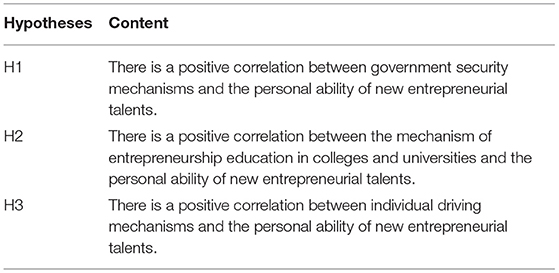
Table 4. Hypotheses on the relationship between the qualities and the influencing factors of the entrepreneurial ability of new entrepreneurial talents.
(2) The questionnaire survey (QS) is designed, distributed, collected, and processed. The questionnaire includes the basic information of the tested enterprises and the employees, the qualities of new entrepreneurial talents, and the influencing factors of training new entrepreneurial talents. At the same time, the psychological state scale of new entrepreneurial talents is designed, including the success motivation scale and the self-confidence scale. The contents of the success motivation scale and the self-confidence scale are shown in Tables 5, 6.
The subjects are randomly selected and 20 new ventures in Xi'an Shaanxi Province are investigated. A total of 350 questionnaires are distributed, and 300 valid questionnaires are collected after the invalid are excluded. The recovery rate is 85.7%. After that, 30 enterprise managers are randomly selected to explore their psychological states.
(3) Descriptive statistics are used to test the reliability and the validity of the scale and conduct the variance analysis. The Statistical Product and Service Solutions (SPSS26.0) is applied to conducting descriptive statistics of the selected enterprises, including the establishment time, the number of employees, the types of jobs, and the age of the employees and their educational levels. Then, the reliability and validity of the questionnaire are analyzed, and variance analysis is conducted on whether there are differences in the entrepreneurial ability of new entrepreneurial talents and the influencing factors of cultivating new entrepreneurial talents. Origin 2018 64-bit is utilized to visualize the data.
Results
Reliability and Validity of the QS
The reliability and validity of the questionnaire are tested, as shown in Figures 3A,B.
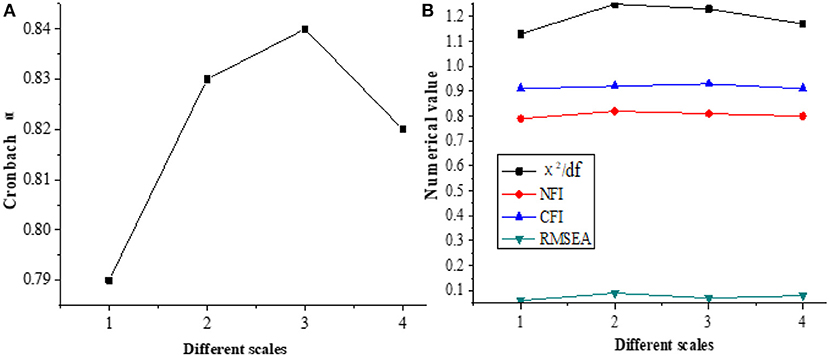
Figure 3. Reliability and validity of the questionnaire (A) Reliability; (B) Validity; 1. Scale of the qualities of the entrepreneurial ability of new entrepreneurial talents; 2. Scale of the influencing factors of cultivating the entrepreneurial ability of new entrepreneurial talents).
Therefore, the Cronbach α coefficient of each scale is between 0.79 and 0.85, indicating that the reliability of the scale is ideal. The χ2/df value of each scale is <2, and RMSEA is between 0.05 and 0.1, showing that the scale has a good fitting ability to the data and can be used in the study.
The Establishment Time and the Number of Employees
The establishment time and the number of the employees from the 20 enterprises are studied, as shown in Figures 4A,B.
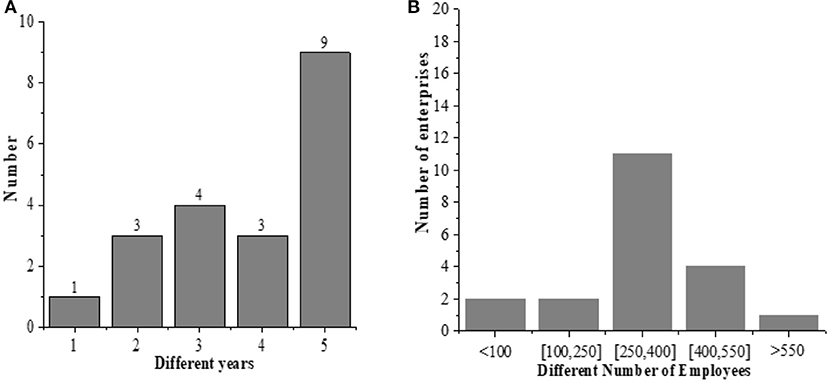
Figure 4. The establishment time and the number of the employees (A: the establishment time; B: the number of employees).
The results show that the establishment time of one enterprise is 1 year, and that of three enterprises is 2 years, that of four enterprises is 3 years, that of three enterprises is 4 years, and that of nine enterprises is 5 years. The number of employees in two enterprises is <100, in two enterprises are between100 and 250, in 11 enterprises are between 250 and 400, in four enterprises are between 400 and 550, and in one enterprise are more than 550. This shows that the number of the employees in the surveyed new ventures is between 250 and 400, and most of the new ventures are established in about 5 years, which meets the requirements of new ventures.
Nature of the Ventures and the Positions of Their Employees
The nature of the new ventures and the positions of the employees are statistically analyzed, as shown in Figures 5A,B.

Figure 5. Nature of the new ventures and the positions of the interviewees (A. Nature; 1. A metallurgical company; 2. A construction company; 3. A software company; 4. A food company; 5. A biomedical company; 6. An energy and raw materials company; 7. A clothing company; 8. A water conservancy company; B. The positions of interviewees; a. Corporate executives; b. Salesmen; c. Production personnel; d. R and D personnel; e. After-sale employees).
Among the 20 enterprises, one is a metallurgical company, two are construction companies, four are software companies, four are food companies, and one is a biomedical company. Also, two are energy and raw material companies, three are clothing companies, and three are water conservancy companies. Among the 300 interviewees, 110 of them are corporate executives, 65 are sales, 32 are production employees, 63 are R and D personnel, and 30 are after-sale personnel. This shows that most of the surveyed new ventures are software companies or food companies, and most subjects in the ventures are managers, indicating that new entrepreneurial talents prefer the emerging industries, and they have strong working abilities.
Age, Gender, and Education of the Subjects
The genders of the 300 subjects are statistically analyzed, as shown in Figure 6.
Among the subjects, there are 191 male entrepreneurs and 109 female entrepreneurs, and the proportion of male-female is not balanced. Thus, different innovative strategies should be employed according to the gender ratio of new venture entrepreneurs. Effective policies should be provided to improve the entrepreneurial ability of female entrepreneurs, thereby improving the proportion of female entrepreneurs. In this case, H1 is verified.
The age and educational levels of the 300 employees are analyzed, as shown in Figure 6.
About 30 subjects are <30 years old, 60 are 30–35 years old, 108 are 35–40 years old, 69 are 40–45 years old, and 33 are over 45. There are nine subjects with a degree below a junior college, 45 with a junior college degree, 204 with a bachelor degree, 30 with a master degree, and 12 with a doctor degree. Most of the subjects are young people aged between 35–40 years, and most of them are managers. 82% of them have a bachelor degree or above. This indicates that the educational levels of new entrepreneurs are high as shown in Figure 7.
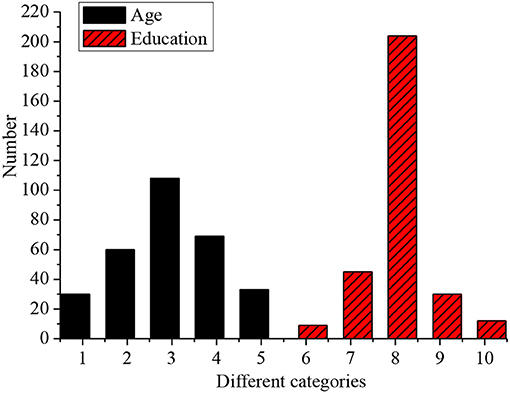
Figure 7. Age and education of the interviewees (1. <30 years old; 2. 30–35 years old; 3. 35–40 years old; 4. 40–45 years old; 5. Over 45 years old; 6. Below junior college degree; 7. Junior college; 8. Bachelor degree; 9. Master degree; 10. Doctor degree).
Therefore, young people with higher education should be cultivated and an entrepreneurial talent library should be established so that enterprises can use the strategies in the library to innovate their talent training mode. On this basis, H2 is verified.
Psychological States of New Entrepreneurial Talents
The psychological states of the subjects are statistically analyzed, as shown in Figure 8.
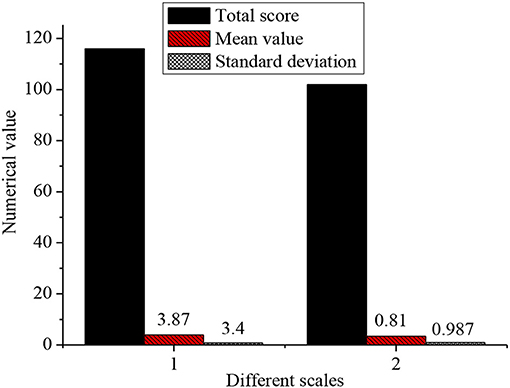
Figure 8. Psychological states of new entrepreneurial talents (1. Entrepreneurial motivation; 2. Self-confidence).
The total score of the entrepreneurial motivation scale is 116, with an average of 3.87 and an SD of 0.81. The total score of the self-confidence scale is 102, with an average of 3.4 and an SD of 0.987. The scores of both scales are high and H3 is verified. This indicates that new entrepreneurial talents have more self-confidence and strong entrepreneurial motivation during entrepreneurship, thereby greatly increasing the possibility of entrepreneurial success.
Optimization of the Innovative Training Mechanism of New Entrepreneurial Talents
The optimization of the innovative training mechanism of new entrepreneurial talents is carried out, as shown in Figure 9.
The training mechanism of industry-university cooperation should be optimized through the government security mechanism, with the entrepreneurial practice platform as the core and the strategic alliance of industry-university-research cooperation as the link. Meanwhile, the qualities and comprehensive ability of new venture entrepreneurs should be improved, and the training mechanism of industry-university cooperation is optimized. Besides, the individual driving mechanism should be optimized to arouse the entrepreneurial intention of new venture entrepreneurs. In short, based on the guarantees of the policies of governments, the entrepreneurship mechanism and the qualities of the talents play the greatest role in the innovative training of new entrepreneurial talents, and new entrepreneurial talents can achieve their optimal working ability and psychological capital.
Conclusion
The training model is established to cultivate the entrepreneurial ability of new entrepreneurial talents, and some research hypotheses are proposed. The survey is conducted based on a QS. Then, the influencing factors of the psychological states of new entrepreneurial talents are analyzed. The results show that the number of employees in most of the surveyed enterprises is moderate, and more than a third of the subjects is the head of the enterprise. Meanwhile, most subjects in the new ventures are young people aged between 35 and 40, and the education that they receive is at least an undergraduate degree, and more than 80% of them have the education in colleges. The scores of psychological states of new entrepreneurial talents are good, indicating that in innovative training of new entrepreneurial talents, attention should be paid to improving the psychological states and practical ability of new entrepreneurial talents. There are some shortcomings in the study. The number of the research samples is small, which affects the applicability of the research results. In the later research, the sample size and scope will be expanded so that the research results will be more convincing and applicable.
Data Availability Statement
The raw data supporting the conclusions of this article will be made available by the authors, without undue reservation.
Ethics Statement
The studies involving human participants were reviewed and approved by Party School of CPC Shandong Provincial Committee Ethics Committee. The patients/participants provided their written informed consent to participate in this study. Written informed consent was obtained from the individual(s) for the publication of any potentially identifiable images or data included in this article.
Author Contributions
The author confirms being the sole contributor of this work and has approved it for publication.
Conflict of Interest
The author declares that the research was conducted in the absence of any commercial or financial relationships that could be construed as a potential conflict of interest.
Publisher's Note
All claims expressed in this article are solely those of the authors and do not necessarily represent those of their affiliated organizations, or those of the publisher, the editors and the reviewers. Any product that may be evaluated in this article, or claim that may be made by its manufacturer, is not guaranteed or endorsed by the publisher.
References
Bhagavatula, S., Mudambi, R., and Murmann, J. P. (2017). Management and organization review special issue ‘the innovation and entrepreneurship ecosystem in India'. Manag Organ Rev. 13, 209–212. doi: 10.1017/mor.2017.11
Boso, N., Danso, A., Leonidou, C., Uddin, M., Adeola, O., and Hultman, M. (2017). Does financial resource slack drive sustainability expenditure in developing economy small and medium-sized enterprises? J Bus Res. 80, 247–256. doi: 10.1016/j.jbusres.2017.06.016
Chen, M. (2019). The impact of expatriates' cross-cultural adjustment on work stress and job involvement in the high-tech industry. Front. Psychol. 67:2228. doi: 10.3389/fpsyg.2019.02228
Chen, M. J. (2018). Scholarship-practice “oneness” of an academic career: the entrepreneurial pursuit of an expansive view of management scholarship. Asia Pacific J. Manag. 35, 859–886. doi: 10.1007/s10490-018-9625-5
Gast, J., Gundolf, K., and Cesinger, B. (2017). Doing business in a green way: a systematic review of the ecological sustainability entrepreneurship literature and future research directions. J. Clean. Prod. 147, 44–56. doi: 10.1016/j.jclepro.2017.01.065
Ghaferi, A. A., and Dimick, J. B. (2016). Importance of teamwork, communication and culture on failure-to-rescue in the elderly. Br. J. Surg. 103, e47–e51. doi: 10.1002/bjs.10031
He, Y., Guo, J., and Zheng, X. (2018). From surveillance to digital twin: challenges and recent advances of signal processing for industrial internet of things. IEEE Signal Process Mag. 35, 120–129. doi: 10.1109/MSP.2018.2842228
Hoppe, M. (2016). Policy and entrepreneurship education. Small Bus. Econ. 46, 13–29. doi: 10.1007/s11187-015-9676-7
Hu, W., and Wang, R. (2019). Segregation in urban education: Evidence from public schools in Shanghai, China. Cities 87, 106–113. doi: 10.1016/j.cities.2018.12.031
Ju, W., and Zhou, X. (2020). Institutional environment and entrepreneurial intention of academics in China. Soc. Behav. Pers. 48, 1–15. doi: 10.2224/sbp.8945
Krugh, M., Garimella, R. S., Baburaj, A., Wescoat, E., and Mears, L. (2020). Closed loop feedback mechanism effect pilot investigation on manual assembly time and process variation. Procedia Manuf. 48, 95–104. doi: 10.1016/j.promfg.2020.05.025
Li, Y., Green, S., and Hirsch, P. M. (2018). Rhetoric and authority in a polarized transition: the case of China's stock market. J. Lnpu. Edu. 27, 69–95. doi: 10.1177/1056492616682620
Moldovan, N. C. (2017). Does the quality of public policies and institutions matter for entrepreneurial activity? Evidence from the European Union's member states. Panoeconomicus 63, 425–439. doi: 10.2298/PAN1604425D
Obschonka, M., Lee, N., Rodríguez-Pose, A., Eichstaedt, J. C., and Ebert, T. (2020). Big data methods, social media, and the psychology of entrepreneurial regions: capturing cross-county personality traits and their impact on entrepreneurship in the USA. Small Bus. Econ. 55, 567–588. doi: 10.1007/s11187-019-00204-2
Qian, J., Song, B., Jin, Z., Wang, B., and Chen, H. (2018). Linking empowering leadership to task performance, taking charge, and voice: the mediating role of feedback-seeking. Front. Psychol. 9:2025. doi: 10.3389/fpsyg.2018.02025
Richmond, H., Copsey, B., Hall, A. M., Davies, D., and Lamb, S. E. (2017). A systematic review and meta-analysis of online versus alternative methods for training licensed health care professionals to deliver clinical interventions. BMC Med. Educ. 17:227. doi: 10.1186/s12909-017-1047-4
Salter, A. J., and Mckelvey, M. (2016). Evolutionary analysis of innovation and entrepreneurship: Sidney, G. Winter-recipient of the 2015 global award for entrepreneurship research. Small Bus. Econ. 47, 1–14. doi: 10.1007/s11187-016-9702-4
Sarmiento, F. O. (2020). Montology manifesto: echoes towards a transdisciplinary science of mountains. J. Mt. Sci. 17, 2512–2527. doi: 10.1007/s11629-019-5536-2
Sklaveniti, C. (2017). Processes of entrepreneurial leadership: Co-acting creativity and direction in the emergence of new SME ventures. Int. Small Bus. J. 35, 197–213. doi: 10.1177/0266242616673420
To, C. K. M., Martínez, J. M. G., Orero-Blat, M., and Chau, K. P. (2020). Predicting motivational outcomes in social entrepreneurship: Roles of entrepreneurial self-efficacy and situational fit. J. Bus. Res. 67, 209–222. doi: 10.1016/j.jbusres.2020.08.022
Valk, V. D. P. (2016). Quality assurance in postgraduate pathology training the Dutch way: regular assessment, monitoring of training programs but no end of training examination. Virchows Arch. 468, 109–113. doi: 10.1007/s00428-015-1895-4
Wu, W., Wang, H., Zheng, C., and Wu, Y. J. (2019). Effect of narcissism, psychopathy, and machiavellianism on entrepreneurial intention-the mediating of entrepreneurial self-efficacy. Front. Psychol. 10:360. doi: 10.3389/fpsyg.2019.00360
Wu, Y., and Song, D. (2019). Gratifications for social media use in entrepreneurship courses: learners' perspective. Front. Psychol. 10:1270. doi: 10.3389/fpsyg.2019.01270
Yi, S., and Duval-Couetil, N. (2018). What drives engineering students to be entrepreneurs? Evidence of validity for an entrepreneurial motivation scale. J. Eng. Educ. 107, 291–317. doi: 10.1002/jee.20199
Zaremohzzabieh, Z., Ahrari, S., Krauss, S. E., Abu, S. A., Meng, L. K., and Ariffin, Z. (2018). Predicting social entrepreneurial intention: a meta-analytic path analysis based on the theory of planned behavior. J. Bus. Res. 96, 264–276. doi: 10.1016/j.jbusres.2018.11.030
Zeng, H., Zheng, Z., and Wang, P. (2020). Characteristics of psychological crisis and its risk factors among adolescents in China. J. Child. Fam. Stud. 29, 1–10. doi: 10.1007/s10826-020-01773-7
Zhang, C., Ye, M., Fu, Y., Yang, M., and Tao, Q. (2020). The psychological impact of the COVID-19 pandemic on teenagers in China. J. Adolesc. Health. 67, 747–755. doi: 10.1016/j.jadohealth.2020.08.026
Zhang, N., and Ma, G. (2018). Childhood obesity in China: trends, risk factors, policies, and actions. J. Glob. Health. 2, 1–13. doi: 10.1016/S2414-6447(19)30115-0
Zhao, H., and Lu, J. (2016). The contingent value of political capital in bank loan acquisition: evidence from founder-controlled private enterprises in China. J. Bus. Ventur. 31, 153–174. doi: 10.1016/j.jbusvent.2015.12.002
Keywords: higher education, new entrepreneurial talents, training mechanism, innovative strategy, innovative training
Citation: Wei F (2021) Innovative Strategies of Training Mechanism of Higher Education for New Entrepreneurial Talents. Front. Psychol. 12:696978. doi: 10.3389/fpsyg.2021.696978
Received: 18 April 2021; Accepted: 05 July 2021;
Published: 09 August 2021.
Edited by:
Xingyi Ma, Harbin Institute of Technology, ChinaReviewed by:
Apple Liu, Sultan Idris University of Education, MalaysiaWen Hai Xu, Tongji University, China
Copyright © 2021 Wei. This is an open-access article distributed under the terms of the Creative Commons Attribution License (CC BY). The use, distribution or reproduction in other forums is permitted, provided the original author(s) and the copyright owner(s) are credited and that the original publication in this journal is cited, in accordance with accepted academic practice. No use, distribution or reproduction is permitted which does not comply with these terms.
*Correspondence: Fengyun Wei, weifengyun@shandong.cn
 Fengyun Wei
Fengyun Wei
